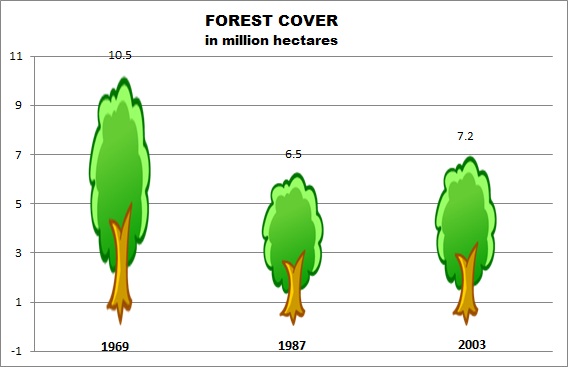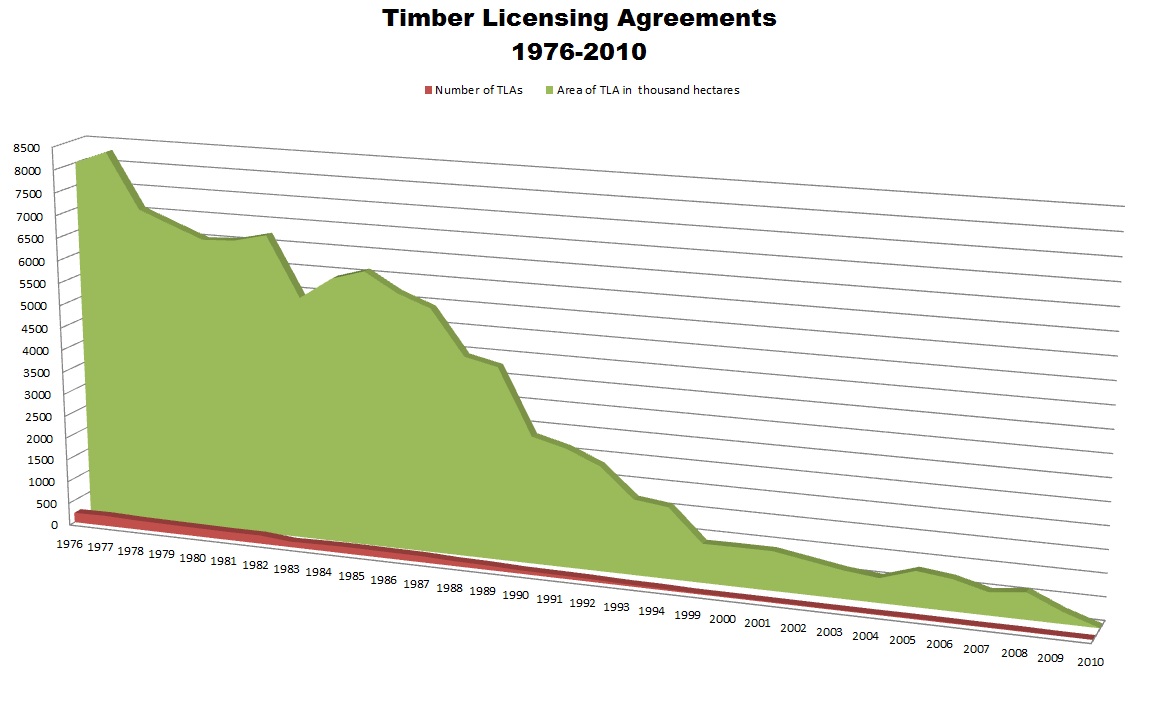Filtered By: Scitech
SciTech
Greener on the other side: Deforestation in the wake of Martial Law
By Shaira Panela, GMA News
Philippine forests were lush before Pres. Ferdinand Marcos declared Martial Law on Sept. 21, 1972.
Forty years after, Philippine forests are still under repair from denudation caused by massive deforestation that started in the Marcos regime:

Forest cover is improving, but it still has a long way to go.Source: Forest Management Bureau
“Alam mo, at that time (1960s to 1974), ang forest cover natin ay even more than 50 percent. Akala natin yung forest resources natin hindi mauubos e...,” said the Department of Environment and Natural Resources' Forest Management Bureau (FMB) director Ricardo Calderon in an interview with GMA News Online.
But the country saw rapid deforestation after Martial Law as Marcos changed the rules on logging leases, from one year to 10-year and even 25-year terms, according to the book “The Political Economy of Growth and Impoverishment in the Marcos Era” by James K. Boyce.
Deforested area the size of 3,500 Araneta Colliseums
Boyce said that, prior to Martial Law, our forest cover was as much as 20 million hectares (ha) —the FMB cites a more conservative figure, 10.5 million ha as of 1969— out of the 30 million ha of the country’s land area.
By 1981, the Food and Agriculture Organization (FAO) of the United Nations, only 9.5 million ha were officially classified as ‘closed forest’—with 70-100% forest cover— and 3 million ha undisturbed, with 2 million ha “severely degraded and incapable of regeneration.”
Based on FMB data, in the 1970's, over 200 timber licensing agreements (TLA) were granted, allowing the cutting of trees in more than 8 million ha of forest land (1976) —an area equivalent to almost 3,500 Araneta Coliseums. But since then, due to changes in government policy as well as dwindling forest cover, the TLAs have been covering increasingly smaller areas over the years:
 Due to government policy changes and dwindling forest cover, TLA are has been decreasing. Source: Forest Management Bureau
Due to government policy changes and dwindling forest cover, TLA are has been decreasing. Source: Forest Management Bureau TLAs are 25-year renewable contract issued by the government to cut trees on not larger than 100,000 hectares.
Quoting DENR-FMB data, Calderon said that, during the 1960s and 1970s, the rate of forest destruction was about 300,000 ha annually.
In fact, the Philippines was a major exporter of logs to countries like the United States and Japan at that time.
“Ang production natin ng logs is around 11.1 million cubic meters. That was around 1974,” said Calderon, quoting their data.
However, at present, the country is now a net importer of logs, Calderon said.
“Ang ating production now is around [just] 840,000 cubic meters. That was in 2005,” he added, citing that it is no longer enough to support the wood needs of the country.
Did cronies get more TLAs?
“Yung TLA kasi is a privilege. Hindi basta na-acquire iyan ng ordinaryong tao. If they are not in the powers that be, ay hindi ka na makakukuha ng TLA....” said Calderon.
During Martial Law, timber concessionaires were allowed to cut trees in rainforests with naturally-grown trees.
“The fact na hindi mo naman itinanim, it's a great privilege,” added Calderon.
This was also seconded by books written on Martial Law.
Colin Kahl said in his book, "States, Scarcity, and Civil Strife in the Developing World," he said that granting timber concessionaires became a way for Marcos to secure continued loyalty of allies and supporters.
United Nations Research Institute for Social Development’s “Forest Policy and Politics in the Philippines” said, “The TLA was given as a gift to retired generals and veterans.”
The study also said that the late president violated his own laws by giving more than a hundred thousand hectares to allies and relatives:
“Alfonso Lim and Felipe Ysmael had licenses to log more than 500,000 and 155,000 ha, respectively. Marcos’s sister Fortuna Marcos-Barba had a concenssion of about 200,000 ha of forest. One of her companies was granted a license by presidential decree.”
The current status of our nation's forests
However, the Philippine forests are now recuperating from damage caused by previous decades.
FAO reported that Philippines is one of the two ASEAN countries with positive reforestation results as of 2011.
Calderon said this could be chalked up to the Philippine government’s aggressive reforestation project.
“[Things are getting better] because we banned the cutting of logs in virgin forests. That was 1986, with the entry of Pres. Aquino. Focused ngayon yung mga IFMA (Integrated Forest Management Agreement) sa residual forest—natural residual forests, ibig sabihin mga logged over areas na. Napreserve natin yung virgin forests natin na about 890,000 hectares,” he said.
IFMA refers to the 25-year renewable contract to “develop, manage, protect and utilize” 500 ha to 40,000 ha of forest land. All TLAs were converted to IFMAs BY 1999. (See primer here.)
By 2011, Pres. Benigno S. Aquino III imposed Executive Order No. 23, banning the cutting and harvesting of timber in natural and residual forests.
“So, effectively, all IFMAs with operating permits should now stop operations,” said Calderon.
But he also said that, while the government has already invested in massive reforestation and forest protection, he admitted that there are still illegal loggers at large.
“In Luzon, for the small-scale, we call them poachers. But the large-scale loggers are there in Mindanao —in the Agusan provinces,” said Calderon.
As of this year alone, 29 of their foresters died in the line of duty while hunting down illegal loggers in Agusan alone, he said. — TJD, GMA News
Tags: martiallawmarcos, martiallaw
More Videos
Most Popular



